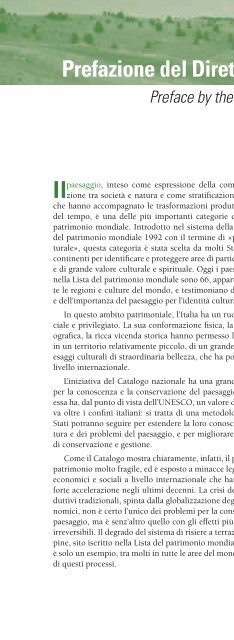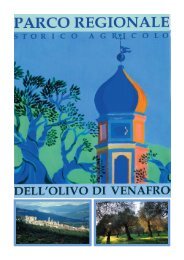Scarica il documento (1.51 MB) - Rete Rurale Nazionale
Scarica il documento (1.51 MB) - Rete Rurale Nazionale
Scarica il documento (1.51 MB) - Rete Rurale Nazionale
Create successful ePaper yourself
Turn your PDF publications into a flip-book with our unique Google optimized e-Paper software.
Prefazione del Direttore dell’UNESCO WHC<br />
Preface by the Director-General of UNESCO WHC<br />
paesaggio, inteso come espressione della complessa intera-<br />
Il zione tra società e natura e come stratificazione dei processi<br />
che hanno accompagnato le trasformazioni produttive nel corso<br />
del tempo, è una delle più importanti categorie della Lista del<br />
patrimonio mondiale. Introdotto nel sistema della Convenzione<br />
del patrimonio mondiale 1992 con <strong>il</strong> termine di «paesaggio culturale»,<br />
questa categoria è stata scelta da molti Stati dei diversi<br />
continenti per identificare e proteggere aree di particolare bellezza<br />
e di grande valore culturale e spirituale. Oggi i paesaggi culturali<br />
nella Lista del patrimonio mondiale sono 66, appartengono a tutte<br />
le regioni e culture del mondo, e testimoniano della ricchezza<br />
e dell’importanza del paesaggio per l’identità culturale dei popoli.<br />
In questo ambito patrimoniale, l’Italia ha un ruolo molto speciale<br />
e priv<strong>il</strong>egiato. La sua conformazione fisica, la posizione geografica,<br />
la ricca vicenda storica hanno permesso la formazione,<br />
in un territorio relativamente piccolo, di un grande varietà di paesaggi<br />
culturali di straordinaria bellezza, che ha pochi paralleli a<br />
livello internazionale.<br />
L’iniziativa del Catalogo nazionale ha una grande importanza<br />
per la conoscenza e la conservazione del paesaggio italiano. Ma<br />
essa ha, dal punto di vista dell’UNESCO, un valore di esempio che<br />
va oltre i confini italiani: si tratta di una metodologia che molti<br />
Stati potranno seguire per estendere la loro conoscenza della natura<br />
e dei problemi del paesaggio, e per migliorare i loro sistemi<br />
di conservazione e gestione.<br />
Come <strong>il</strong> Catalogo mostra chiaramente, infatti, <strong>il</strong> paesaggio è un<br />
patrimonio molto frag<strong>il</strong>e, ed è esposto a minacce legate a processi<br />
economici e sociali a livello internazionale che hanno visto una<br />
forte accelerazione negli ultimi decenni. La crisi dei sistemi produttivi<br />
tradizionali, spinta dalla globalizzazione degli scambi economici,<br />
non è certo l’unico dei problemi per la conservazione del<br />
paesaggio, ma è senz’altro quello con gli effetti più drammatici e<br />
irreversib<strong>il</strong>i. Il degrado del sistema di risiere a terrazze delle F<strong>il</strong>ippine,<br />
sito iscritto nella Lista del patrimonio mondiale in pericolo,<br />
è solo un esempio, tra molti in tutte le aree del mondo, dell’effetto<br />
di questi processi.<br />
Landscape, intended as an expression of the<br />
complex interaction between society and nature<br />
and the stratification of the processes that<br />
accompanied productive transformations in<br />
the course of time, is one of the most important<br />
categories in the World Heritage List. It was introduced<br />
in the system of the World Heritage<br />
Convention of 1992 under the qualification of<br />
«cultural landscape». This category was used<br />
by many states in different continents to identify<br />
and designate for protection areas of special<br />
beauty and great cultural and spiritual value.<br />
Today, there are 66 cultural landscapes in the<br />
World Heritage List, located in regions and cultures<br />
all over the world. They are a testimony<br />
to the importance of landscape for the cultural<br />
identities of peoples.<br />
In this context, Italy has a very special and priv<strong>il</strong>eged<br />
role. Its physical morphology, geographical<br />
position and rich history have favored<br />
the rise, within a relatively small territory, of a<br />
remarkable variety of cultural landscapes of extraordinary<br />
beauty, with few parallels elsewhere.<br />
The National Catalogue initiative is of great importance<br />
for our understanding of the Italian<br />
landscape and its conservation. Besides, from<br />
the point of view of UNESCO, it stands as an<br />
example, even outside of Italy, of a methodology<br />
that many states could adopt to improve<br />
their knowledge of the nature of their landscape<br />
and the issues affecting it, as well as their landscape<br />
conservation and management systems.<br />
As the Catalogue clearly shows, landscape is<br />
a very vulnerable heritage, exposed to threats<br />
arising from international economic and social<br />
processes that have witnessed a sharp acceleration<br />
over the last decades. The crisis of<br />
traditional production systems brought about<br />
by the globalization of economic exchanges is<br />
certainly not the only threat to landscape conservation,<br />
but it is certainly the one producing<br />
the most dramatic and irreversible effects. The<br />
deterioration of the terraced rice paddies of<br />
the Ph<strong>il</strong>ippines, included in the List of World<br />
Heritage in Danger, is only an example among<br />
many all over the world of the effects of these<br />
processes. Even in Italy, many traditional<br />
IX



